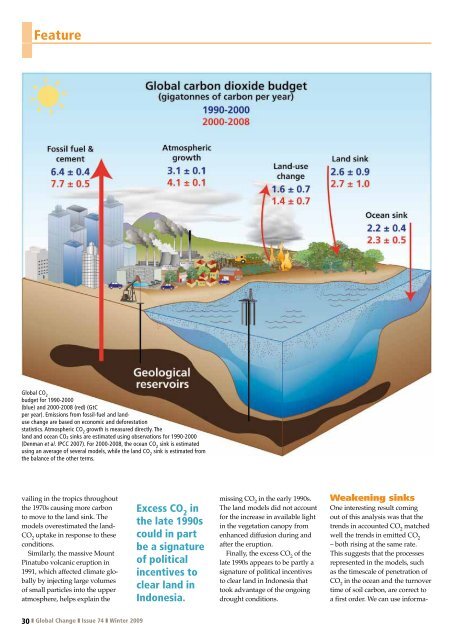Planetary boundarIes
Planetary boundarIes
Planetary boundarIes
Create successful ePaper yourself
Turn your PDF publications into a flip-book with our unique Google optimized e-Paper software.
Feature<br />
global CO 2<br />
budget for 1990-2000<br />
(blue) and 2000-2008 (red) (gtC<br />
per year). Emissions from fossil-fuel and landuse<br />
change are based on economic and deforestation<br />
statistics. Atmospheric CO 2 growth is measured directly. The<br />
land and ocean CO2 sinks are estimated using observations for 1990-2000<br />
(Denman et al. IPCC 2007). For 2000-2008, the ocean CO 2 sink is estimated<br />
using an average of several models, while the land CO 2 sink is estimated from<br />
the balance of the other terms.<br />
vailing in the tropics throughout<br />
the 1970s causing more carbon<br />
to move to the land sink. The<br />
models overestimated the landco<br />
2 uptake in response to these<br />
conditions.<br />
similarly, the massive Mount<br />
Pinatubo volcanic eruption in<br />
1991, which affected climate globally<br />
by injecting large volumes<br />
of small particles into the upper<br />
atmosphere, helps explain the<br />
30 ❚ Global Change ❚ Issue 74 ❚ Winter 2009<br />
excess Co 2 in<br />
the late 1990s<br />
could in part<br />
be a signature<br />
of political<br />
incentives to<br />
clear land in<br />
Indonesia.<br />
missing co 2 in the early 1990s.<br />
The land models did not account<br />
for the increase in available light<br />
in the vegetation canopy from<br />
enhanced diffusion during and<br />
after the eruption.<br />
Finally, the excess co 2 of the<br />
late 1990s appears to be partly a<br />
signature of political incentives<br />
to clear land in Indonesia that<br />
took advantage of the ongoing<br />
drought conditions.<br />
Weakening sinks<br />
one interesting result coming<br />
out of this analysis was that the<br />
trends in accounted co 2 matched<br />
well the trends in emitted co 2<br />
– both rising at the same rate.<br />
This suggests that the processes<br />
represented in the models, such<br />
as the timescale of penetration of<br />
co 2 in the ocean and the turnover<br />
time of soil carbon, are correct to<br />
a first order. We can use informa

















